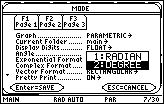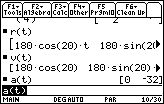It is useful to find a vector function that models the path of a projectile. Such a function can yield the particle's position at time t as well as it's velocity and acceleration. This lesson will explore finding the function that models the path of such an object given some initial information.
Finding the Position Vector
A projectile is fired from ground level. If the starting point for the projectile is considered to be the origin and if air resistance is neglected, the position vector for the projectile at time t is
![]()
where v0 is the initial velocity of the projectile,
![]() is the angle from the horizontal at which the projectile is fired and g is the acceleration due to gravity.
is the angle from the horizontal at which the projectile is fired and g is the acceleration due to gravity.
The position vector can also be represented with the parametric equations

Exploring a Specific Example
Suppose a projectile is fired at an angle of
![]() = 20°
from the horizontal with an initial velocity of 180 ft/sec. Graph the path of the projectile using 32 ft/sec2 for g.
= 20°
from the horizontal with an initial velocity of 180 ft/sec. Graph the path of the projectile using 32 ft/sec2 for g.
- Switch to Degree mode

- Set xt1(t) = 180*t*cos(20)
- Set yt1(t) = 180*t*sin(20) – (1/2)*32*t^2

- Enter the following window values

- Graph the path of the object
24.3.1 Use the trace key to approximate when the projectile reaches its highest point and the maximum height. Click here for the answer.
Recalling Previous Functions
If you have not cleared the variables r,v and a since Lesson 24.2, these variables should still be defined as the position, velocity and acceleration vectors for the parametric equations stored in xt1 and yt1. If you have cleared these variables, redefine them as they were defined in Lesson 24.2.
- Define r(t) = [xt1(t), yt1(t)]
- Define v(t) = d (r(t), t)
- Define a(t) = d (r(t), t, 2)
Verify that these functions have been updated with the new parametric equations
- Enter r(t)
- Enter v(t)
- Enter a(t)

Notice the acceleration vector is 0i - 32j for all values of t because the only force acting on the projectile is gravity.
Finding the Highest Point
Find the vertical component of the velocity vector.
- Enter v(t)[1,2]
|
|||
|
|
|||

When the projectile reaches its highest point the vertical component of the velocity vector is zero.
24.3.2 Find when the projectile reaches it highest point by entering
solve(v(t)[1,2] = 0, t)
Click here for the answer.
24.3.3 Evaluate the position vector at the value of t that makes the vertical component of the velocity zero.
Click here for the answer.